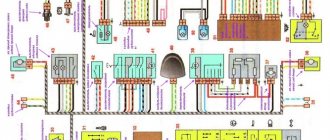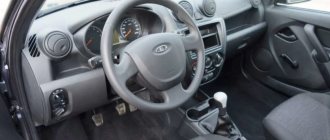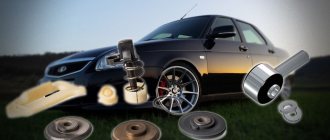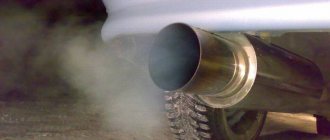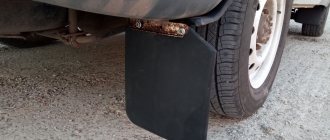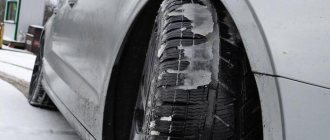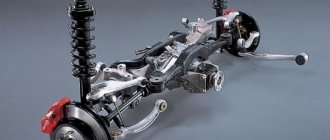Cars admin26.02.2020
Previously I wrote that while driving, at a speed of 90-110 km/h, there is vibration on the steering wheel, at higher speeds the vibration disappears. Here they lifted the car and spun it with and without wheels. We came to the conclusion that the right drive was crooked. I bought the drive, replaced it, nothing changed. We started spinning the car on the stand again, the vibration of the right wheel was strange, up and down. We decided that the wheel bearing was a factory defect. Replaced the hub and bearing. Let's go check it out. The vibration doesn't want to say goodbye to the car. Everything remains as it was. Question to the experts: What could be? How to beat this damn vibration? Maybe look at this reason more globally? For example, rods, steering rack, gearbox, etc.
A request to non-specialists and kind people. If you like it, maybe this blog will reach a person who is faced with this problem.
Thank you in advance.
Price: 259,000 ₽ Mileage: 37,200 km
Vibration in the car
It can drive any driver crazy if the car shakes. But fortunately, in 75 percent of cases, the cause of the car shaking can be eliminated, which will allow the car to return to its former comfort. Each of us wants our car to run smoothly and without vibration. We especially want the car not to disappoint us and to be as before (like new). But, unfortunately, sooner or later any car begins to break down due to natural wear and tear. But this doesn't mean it's time to buy a new car. After all, uneven car performance can occur not only on a fairly used car.
If your car is shaking from an incomprehensible vibration, then the main thing is not to panic. If the car is older than 3-5 years, then most likely some components of the car have exhausted their service life. As they say, the car began to show its age. If you don’t want to overpay for car diagnostics to identify the cause of the shaking, then you can try to identify the problem yourself.
Steering wheel shaking when driving at speed
The most common shaking that occurs in a car is the vibration of the steering wheel when driving at speed. It is noteworthy that such shaking of the steering wheel becomes even greater when accelerating. As a rule, the vibration on the steering wheel is barely noticeable at first, but then becomes more and more severe. Be aware that vibration in the steering wheel can cause serious damage that can lead to an accident due to loss of control.
Also, if you do not pay attention to steering wheel vibration, this can subsequently lead to rapid wear of many vehicle components (from tires to transmission).
Therefore, if there is vibration in the steering wheel in your car, you must check the following elements of the car:
–
Check wheel balancing. Contact a tire shop to check wheel balancing. Unbalanced wheels can cause strong vibration in the steering wheel at speed. This is the simplest cause of steering wheel wobble, which can be eliminated without much expense.
– Replace shock absorbers or struts . Worn struts or shock absorbers can cause the suspension to perform unevenly, causing the vehicle to shake. Shaking will be especially noticeable on uneven roads or at high speed.
– Check the strut support bearing . They are located on top of the shock absorbers. From the front you can check them under the hood. If they are worn out, replace these components, which may cause vibration when driving at speed.
– Check and replace ball joints if necessary . Ball joints often become unusable due to uneven and bad roads. In our country, ball joints last much less than on cars used in Europe. If these components have play, then when moving, this often leads to shaking in the car.
– Check and replace tie rod ends .
Steering ends begin to “loose” over time due to wear. Thanks to them, your wheels turn parallel. If the steering lugs are worn out, the front wheels may not be parallel, which will cause shaking (vibration) in the steering wheel.
Wheel imbalance
This is one of the most common causes of steering wheel wobble at speed. If one or more wheels are not balanced according to requirements, the driver will constantly feel at speed that the steering wheel vibrates a little. Moreover, in such a situation, runout can occur at both low and high speeds, and can also be constant.
Very often there is a beating of the steering wheel when the engine reaches a certain speed. As a rule, this is explained by the fact that the load in the wheels of the car is shifted for balancing and unauthorized alignment occurs. When the engine slows down, the problem disappears by itself.
For understanding, let's give an example of a centrifuge from a regular washing machine. If the clothes inside are placed incorrectly and unevenly, then when the speed increases, strong vibration will occur, which disappears at high speed. The fact is that centrifugal force comes into play and normalizes the center of gravity, and the things inside are distributed independently. The same can be said about a car.
The solution to this problem of runout is to visit a service station and have the wheels balanced. It should be noted that before embarking on such a procedure, wash the discs well, since if there is dirt on them during balancing, its effect will soon fade away. Also pay attention to the condition and position of the weights, which should be close to each other on each side.
The car shakes at idle
If your car shakes when you are stopped at a traffic light, then most likely something has gone wrong. To determine the cause of idle vibration, check the following:
– Broken or worn engine mounts . Broken or severely worn powertrain mounts do not support your engine properly, causing detonation from the engine to be transferred to the body.
– Problems in the fuel system . If the engine speed suddenly drops or increases, it may cause the vehicle to shake or vibrate. In order to find the cause, it is necessary to fully diagnose, using special equipment, the operation of the entire fuel system, starting from various electronic sensors and ending with the fuel pump.
Steering wheel beating at speeds of 100-120 km/h due to poor-quality wheel fastening
If your wheel nuts are not fastened firmly and securely enough, this is also the cause of vibration of the steering wheel and the entire car at speed. Loose nuts are one of the simplest and most easily diagnosed problems, but also the most dangerous. If you don’t pay attention to the incorrect operation of the wheels in time and while driving they fly off from your car, an accident cannot be avoided, which will end badly not only for you, but also for other people.
Repairing a car in the event of a “lost” wheel can cost a considerable amount of money if the problem is not diagnosed in time. In this case, it may be necessary to replace the brake disc, hub or other components. To be confident in your car, it is better to securely secure the nuts and bolts on the wheels or entrust the matter to professionals for maintenance.
Don’t forget about other important parts of the car; in particular, we recommend that you read the article on checking the battery charge.
The car shakes when accelerating
Vibration or shaking when accelerating a car can cause the most unpleasant sensations of discomfort in a car. The worst thing is when you count on rapid acceleration of the car (for example, to overtake a car), but when you press the gas pedal, you get in response, uneven acceleration with jerks.
In order to find out why the car shakes during acceleration, you need to check the following:
– Low oil level in the gearbox . Yes, a low level of transmission fluid can cause vibration and dips in the acceleration dynamics of the car when accelerating. Including, as a rule, when the oil level in the transmission is insufficient, jerks are observed during acceleration.
– The gearbox filter is clogged . A dirty automatic transmission filter can lead to vibration when accelerating the car. Replace the filter element with a new one yourself or at a car repair shop.
– Wear of the cardan joint . The U-joint on your driveshaft may wear out, causing it to shake or vibrate when you drive or pull away. This is especially obvious when accelerating a car. If the cause of the vibration is really the cardan joint, then do not delay replacing the part, because in the event of a complete breakdown, your car will not be able to move, which threatens with unnecessary expenses for evacuating the car to a car service center.
There can be a huge number of possible problems with a car, and a specific breakdown does not always give specific signs of its presence. Drivers often complain about body shaking when accelerating or at a certain speed. There can be quite a lot of problems that determine this indicator. If your car has vibration during acceleration, you should look at all possible breakdowns and immediately replace the failed components.
We study wheels and chassis - the main cause of vibrations
The main indicator that the wheels or drives of these same wheels are to blame for your problems is shaking at a certain speed. Often these are body vibrations in the range of 80-100 kilometers per hour, but sometimes the shaking may not go away even after 60 km/h, so in any case you need to fully diagnose the chassis.
In this case, it is not necessary to go to a service station and carry out expensive diagnostic operations. It is enough to apply all your knowledge and study each chassis unit for possible breakdown. The most common problems in this case are the following:
- the wheel mounts are unscrewed, which causes vibration on one of the wheels;
- The brake disc is poorly fixed; at speed it begins to vibrate;
- the wheel drive shaft is bent - the body vibrates constantly, with increasing speed the vibration intensifies;
- damaged CV joints - this is the most common problem that causes vibrations on the body;
- The wheel bearings are damaged, which causes shaking at any speed.
The most common problem in this manifestation is CV joints. To check their serviceability, just grab the shaft with your hand and try to turn it. If the shaft has play of more than a couple of millimeters, the CV joint must be replaced. Interestingly, vibrations of the car body during acceleration can be caused by both external and internal CV joints.
You can also easily determine if there is a problem with this chassis mechanism by examining the anthers. If the rubber part of the boot ruptures, we can safely talk about problems with this mechanism. If water, dust and dirt get into the CV joint, the unit will not survive more than a few days.
Wheel alignment and tire quality are another reason for shaking
If the wheel alignment angle is incorrect, vibration, the car pulling to the side, uneven eating of rubber and other unpleasant manifestations are possible. In different models, these problems manifest themselves in different aspects. Adjusting the wheel alignment angles is one of the first processes that needs to be performed after detecting such a nuisance as body vibration.
Problems can also be caused by tires that are worn incorrectly, or a disc after a serious impact. The main processes that can be taken to eliminate body vibration in this case are as follows:
- adjusting the wheel alignment angle at a wheel alignment station;
- replacing tires if there are visual indicators of uneven or excessive wear;
- replacing or repairing a disc that shows dents and uneven rims;
- performing wheel balancing - often during operation the balancing weights fly off.
If the balancing weights have come off the wheel, this may well cause vibrations at speeds of 80 kilometers per hour. The problem is that it is simply impossible to determine this yourself and find out which wheel needs to be sent for balancing. Therefore, you will have to go to a tire shop and have all the wheels of your car balanced.
This is one of the most inexpensive and safest options for breakdowns due to vibration of the body or steering wheel during acceleration. Therefore, the first thing you need to do is check for the presence of such faults, and then transfer suspicions to other options.
Hub destruction
In some situations, the steering wheel may twitch only when accelerating, while in stable motion there will be no problems. Typically, this can be caused by damage to the hub that the wheel is attached to. The reasons may be different: a strong blow or a banal failure of some element of the car’s suspension.
If steering wheel wobble when driving at speed appears during turns, then it is quite difficult to find out what the problem is, since a large number of connections and assemblies are involved in the maneuver. The reasons may be in tie rod ends, rods, bearings and much more. Any such breakdown can cause the steering wheel to jerk. Only service specialists can help and effectively fix the problem after diagnostics and inspection.
Engine mounts, tie rods and other problems
There is another group of problems that cause vibrations when accelerating a car. It is difficult to collect these problems into one bundle, because they are all different and arise for various reasons. Vibration often occurs when one of the engine mounts is broken. This can easily be checked by increasing the speed while shaking.
The gearbox may also be the culprit for this type of problem. If the car starts to shake at 80 kilometers per hour, you can very easily check the fault of the gearbox by performing the following procedures:
- accelerate to a speed of about 85 kilometers per hour;
- depress the clutch and observe the vibration change;
- engage third gear and smoothly release the clutch;
- try accelerating from 50-55 kilometers per hour in last gear.
If the nature of the shaking does not change in all these experiments, the box has nothing to do with this problem. If there is more shaking when the gearbox is engaged, you will have to check whether it is involved in this problem.
Let's sum it up
If you are unable to find the problem that is causing the body or steering wheel to vibrate in your car when accelerating, you should contact a professional. Do not leave this problem, because it can worsen and create dangerous travel conditions for the driver and passengers of the car. It is necessary to respond as quickly as possible to all possible problems and eliminate them by replacing failed machine elements.
Often, to determine the problem, you don’t even have to go to a service station and use expensive diagnostics. It is enough to inspect the car yourself and determine what problems caused the body vibrations. Have you had similar problems in your experience, and what parts of the machine caused them?
Even if car enthusiasts react quite nervously to such common phenomena as the rattling of glass and plastic inside a car, vibration of the steering wheel can put almost every driver in a mental hospital - this is a very annoying and unpleasant process. Jokes aside, vibrations on the steering wheel are a very serious problem. Today we will find out the reasons for its occurrence and tell you how to cope with this disaster.
Causes of vibrations on the steering wheel
As a rule, vibrations in the steering wheel appear under various conditions: when the car is moving at different speeds, braking, or when the car is stationary and its engine is idling. If the beating of the steering wheel has become annoying, you need to determine in what circumstances it manifests itself, and depending on this, diagnose the cause.
Steering wheel wobble when the car is stationary
Vibrations in this case can occur for two reasons: due to loose engine mounts or due to problems with the steering rack drive shaft. In the first option, when the engine is idling, the steering wheel hits quite hard. Such vibrations appear on cars with high mileage: either the mountings of the power unit have become loose over time, or the engine was not installed properly after a major overhaul. If even at low speeds a significant beating of the steering wheel is felt, then as the speed increases, the vibrations increase and driving such a car becomes not only uncomfortable, but also unsafe.
The second option: the occurrence of vibrations at idle speed in a stationary car can be caused by wear of the splined part of the steering rack drive shaft or deformation of the shaft itself. With this option, the steering wheel runout may also increase when the car moves.
You cannot drive with such vibrations for a long time because it can lead to destruction of the steering mechanism elements, and, as a result, loss of control of the car - an accident.
Steering wheel vibration when driving at different speeds
Here there are more factors causing vibrations, and they are mainly related to the condition of the wheels.
Firstly, steering wheel beating can occur due to the fact that the wheel rims become clogged with snow or dirt, which leads to imbalance of the wheels and, as a result, the appearance of those same annoying vibrations. In this case, the steering wheel only shakes at low speeds, and when the speed increases, the vibrations disappear completely.
Secondly, steering wheel vibrations can occur at medium (no more than 60 km/h) and high speeds if the wheels were not properly balanced during a seasonal tire change or after tire repair.
In this case, the masses of the wheels become different; when the speed increases, the centrifugal forces of such wheels differ, which is why the steering wheel wobbles. You can’t drive with unbalanced wheels for a long time - in addition to driving discomfort, you can ruin the tires (uneven wear) or, more seriously, damage the suspension elements (in this case, the hub bearings suffer the most).
Thirdly, steering wheel beating can be caused by deformation of the wheel rims (most often steel wheels are susceptible to this). Most often, vibrations in this case occur after the car has crashed into a pothole with one or even two wheels. It happens that a deformed wheel rim is sold to you in a store or market - this is a manufacturing defect. It is not always possible to determine by eye whether crooked rims are the cause of vibrations on the steering wheel - often this bends the inner part of the rim, not the outer one.
You can diagnose this reason by removing the wheels yourself, or by contacting the nearest tire shop.
Fourthly, steering wheel vibration may occur if the holes in the wheel rim do not match the diameter of the bolts on the wheel hub. This manifests itself when non-original rims are installed on the car. In this case, the disc begins to “jump” on the hub, vibration occurs, which is transmitted to the steering wheel. The higher the speed, the more the steering wheel vibrates.
Fifthly, steering “fever” occurs due to tire defects. This includes deformation of the cord or sidewall of the tire, which can be caused by manufacturing defects or improper use of the rubber (driving on roads with potholes).
Vibration after 120 km h reasons
Hi all.
This means we have a problem with Ksyushka - after 120 km/h vibration appears on the body and on the steering wheel. Moreover, on a perfectly flat road, the smoother the road, the stronger the vibration, but on an uneven road, on the contrary, it is practically not noticeable. When I bought it and at first I was driving around the city, I naturally didn’t notice this (because there’s nowhere in our city with our roads and cameras on every corner to fly like that). Initially there was a vibration of 90-100, I got rid of it by replacing the ball and steering joints (the faucets were ball-type, the tips and rods were noticeably loose). And so I go out onto the highway and identify this jamb. What do we have of the main causes of vibration: From here we come to the most interesting. I came to the officials in Region 62, I think after all the officials, let them sort it out. We spent an hour and a half in the car, checked and tugged at everything we could, and went out for a ride twice. As a result, the following verdict was reached: drive imbalance
. Moreover, the drives say they seem normal, smooth, all bullshit (they measured the whole thing with some kind of special device), but they are worn out... I still don’t really understand what it is, since I’m not good at this - something like fitting drives into a box . That over time something wears out there and a backlash appears, which gives a type of imbalance. They say this issue can be corrected by installing adjusting washers, but we say we will not deal with this matter, because... the car is used and can squeeze out the satellites, gearbox overhaul, all that stuff, why the hell are we in such a mess. In short, I didn’t really understand anything, and I didn’t have time to ask questions (I went during working hours, so I wasted an hour and a half). After I started studying all this, I couldn’t find any information on the Internet, but these washers are indeed present on the differential diagram:
Briefly speaking. What should I do? Maybe someone knows and can say something about this? Yesterday, after diagnostics from the officials in the evening, I just had to go out of town, I tried to drive it, in general I accelerated to 160, and there were some strange things with the vibration, it appeared at 120, at times it dropped to 130, at times it intensified, the strongest was at about 140, Sometimes it disappears at 150, sometimes it doesn’t. I also noticed that it is more under load, when, for example, you accelerate up a hill from 120 and above, and also this moment: you accelerate, it vibrates, then you let off the gas (for example, at 150) and pressed it again, but not so hard - and there is no vibration. Based on my knowledge of the machine's structure, everything seems to be in trouble with the drive shafts. But what to do? Look for a service that will install these additional washers at your own peril and risk? Because it’s kind of scary to perform such an operation yourself. Or, as a friend advises, start by replacing the drives? In general, I really look forward to reasoned opinions, preferably with explanations)
Any driver is very alarmed by situations when vibration appears at a speed of 100-120 km/h on the steering wheel or along the body. And the point here is not only about discomfort, although it must be said that these symptoms are a rather unpleasant phenomenon. If measures are not taken to correct the problem in time, this may lead to a violation of the geometry of the body. This will not happen immediately, but slowly and gradually.
Distortions can provoke a violation of the aerodynamic characteristics, as well as deterioration of the vehicle's handling. In addition, due to vibration effects, cracks can form in the metal, which is not only dangerous in itself, but also requires expensive repairs.
And that's not the whole problem. If the car vibrates at a speed of 100-120 (VAZ 2110 is no exception), this leads to the loosening of various fasteners. This phenomenon can lead to serious consequences - accidents, as well as various malfunctions and damages, which will be very difficult to eliminate. It is worth adding that this kind of shaking is a signal of breakdowns that will yet occur in the near future.
Vibration at speeds of 100-120 km/h occurs for various reasons. These may be completely harmless problems. But sometimes there are serious cases that require global intervention in the technical structure of the car. Further in the article we will look at the typical reasons why vibration is transmitted to the steering wheel and car body at high speeds.
